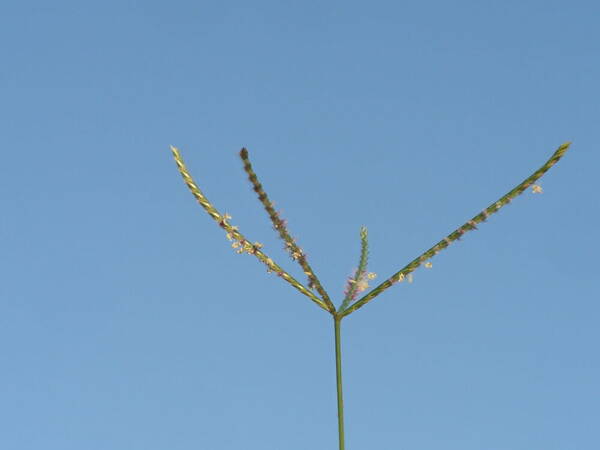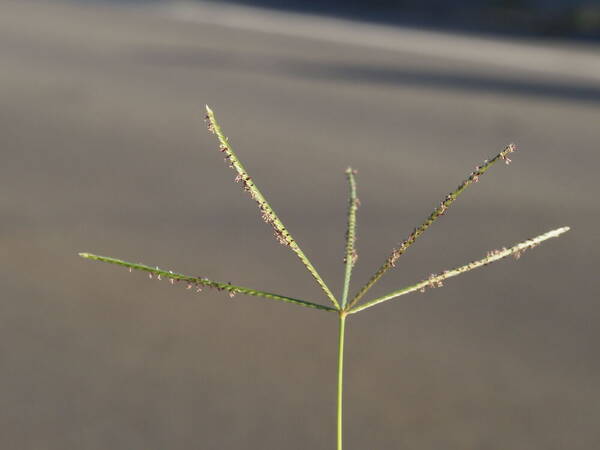Info
Subfamily: Chloridoideae
Genus etymology: Cynodon = "dog's tooth" [Greek] refering to the scales on the stolons
Species etymology: nlemfuensis = from Nlemfu (now often transliterated as Lemfu), Democratic Republic of the Congo
Photosynthetic type: C4 (warm season)
Nativity: naturalized - intentional
First recorded in Hawaiʻi: 1915
Map


Inflorescence




Plant




Habit


Spikelets
 image credit: Mike_Ross
image credit: Mike_Ross






Stolons



Rhizomes


Description
Culms moderately robust to somewhat wiry, 1–1.5 mm. in diameter. Leaf-blades green or glaucous, 2–5 mm. wide. Racemes 4–9, each 4–7 cm. long.
(Description source: Clayton, W.D. 1970. Flora of Tropical East Africa. Gramineae (Part 1). Crown Agents for Oversea Governments and Administrations, London. 176 pp. )
Stoloniferous perennial without rhizomes; stolons stout, lying flat on the ground; culms robust to fairly slender, 30–60 cm. high, soft, not woody (but stolons woody). Leaf-blades flat, mostly 5–16 cm. long, 2–6 mm. wide, thin and green or rather stiff and glaucous, scaberulous, with or without scattered hairs; ligule a scarious rim 0.3 mm. long. Racemes in 1, or sometimes 2, whorls, slender, even flexuous, but not stiffly spreading. Spikelets 2–3 mm. long, green or pigmented with red or purple; glumes narrowly lanceolate in side view, the upper 1/2–3/4 the length of the spikelet (or sometimes equalling the spikelet in var. robustus); lemma silky pubescent to softly ciliate on the keel; palea glabrous.
(Description source: Clayton, W.D. 1970. Flora of Tropical East Africa. Gramineae (Part 1). Crown Agents for Oversea Governments and Administrations, London. 176 pp. )
Stoloniferous perennial without rhizomes; stolons stout and woody, lying flat on the ground; stems robust to fairly slender, up to 60 cm high, soft, not woody. Racemes 4–13 in 1 or 2 whorls, 4–10 cm long. Glumes shorter than the floret, rarely as long; lemma 2–3 mm long, silky-pubescent to softly ciliate on the keel.
(Description source: Cope, T.A, (1995) Flora Somalia, Vol 4. Royal Botanical Gardens, Kew, London. 312 pp. )
Stoloniferous perennial without rhizomes; stolons stout; culms robust to fairly slender, up to 60 cm tall, soft, not woody (but stolons woody); leaf laminas 4–11.5 cm × 2–6 mm, flat.Racemes 4–16 in 1 or sometimes 2 whorls, 4–20 cm long.Spikelets 2–2.6 mm long, green or pigmented with red or purple; glumes narrowly lanceolate in profile, the superior 1/2–3/4 as long as the spikelet; lemma silky-pubescent to softly ciliate on the keel.
(Description source: Pope, G.V. (ed). 1999. Flora Zambesiaca. Volume 10. Part 2. Kew, London. 261 pp. )
Habit: Perennial; mat forming. Rhizomes absent. Stolons present; with alternating elongated and bunched internodes. Culms geniculately ascending; 30-60 cm long; 1-3 mm diam.; firm. Ligule a ciliolate membrane; 0.3 mm long. Leaf-blades flat; 5-16 cm long; 2-6 mm wide; stiff, or firm; mid-green, or glaucous. Leaf-blade surface scaberulous; glabrous, or pilose; sparsely hairy. Inflorescences: Inflorescence composed of racemes. Racemes 4-8(-13); digitate; straight, or flexuous; unilateral; 4-7(-10) cm long. Rhachis flattened. Spikelet packing broadside to rhachis; regular; 2 -rowed. Spikelets appressed; solitary. Fertile spikelets sessile. Spikelets: Spikelets comprising 1 fertile florets; without rhachilla extension. Spikelets ovate; laterally compressed; compressed strongly; 2-3 mm long; breaking up at maturity; disarticulating below each fertile floret. Fertile Spikelets: Spikelets comprising 1 fertile florets; without rhachilla extension. Spikelets ovate; laterally compressed; compressed strongly; 2-3 mm long; breaking up at maturity; disarticulating below each fertile floret. Glumes: Glumes persistent; similar; subequal in width; shorter than spikelet; thinner than fertile lemma. Lower glume lanceolate; 1 length of upper glume; herbaceous; 1-keeled; 1 -veined. Lower glume lateral veins absent. Lower glume apex acute. Upper glume lanceolate; 0.5-0.8 length of adjacent fertile lemma; herbaceous; 1-keeled; 1 -veined. Upper glume lateral veins absent. Upper glume apex acute. Florets: Fertile lemma ovate; laterally compressed; 2-3 mm long; cartilaginous; mid-green, or red; keeled; 3 -veined. Lemma midvein pubescent, or ciliate. Lemma apex acute. Palea 2 -veined. Palea keels eciliate. Fruits: Caryopsis with adherent pericarp. Distribution: Africa: west tropical, west-central tropical, northeast tropical, east tropical, southern tropical, south, and middle Atlantic ocean. Asia-temperate: Arabia. Asia-tropical: Malesia. Australasia: Australia. Pacific: southwestern and north-central. North America: Mexico. South America: Mesoamericana, western South America, Brazil, and southern South America
(Description source: Clayton, W.D., Vorontsova, M.S., Harman, K.T. and Williamson, H. (2006 onwards). GrassBase - The Online World Grass Flora. Available at https://powo.science.kew.org )